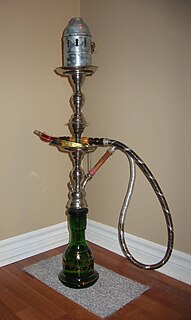
A hookah, also known as the ḡalyān, is a single- or multi-stemmed instrument for vaporizing and smoking flavored tobacco, or sometimes cannabis or opium, whose vapor or smoke is passed through a water basin—often glass-based—before inhalation.

Smoking bans, or smoke-free laws, are public policies, including criminal laws and occupational safety and health regulations, that prohibit tobacco smoking in workplaces and other public spaces. Legislation may also define smoking as more generally being the carrying or possessing of any lit tobacco product.
A smokeasy is a business, especially a bar or drinking venue, which allows smoking despite a smoking ban enacted as a criminal law or an occupational safety and health regulation. The term is also used to describe locations and events promoted by tobacco companies to avoid or evade bans on smoking. The word was added to the New Oxford American Dictionary in 2005, although it was used as early as 1978. It is a portmanteau of smoking and speakeasy.

A hookah lounge is an establishment where patrons share shisha from a communal hookah or from one which is placed at each table or a bar.
The Tobacco Institute, Inc. was a United States tobacco industry trade group, founded in 1958 by the American tobacco industry. It was dissolved in 1998 as part of the Tobacco Master Settlement Agreement.

The use of tobacco for smoking in New Zealand has been subjected to government regulation for a number of decades. On 10 December 2004, New Zealand became the third country in the world to make all indoor workplaces including bars and restaurants smoke-free.

Smoking in Japan, though historically less restricted by law than in many other nations, has significantly changed in recent years. Tobacco use has been in nearly constant decline since 1996 and the decline has been mainly accelerating in recent years. Per capita consumption in 2015 was 1,618 cigarettes, roughly 46% of the peak figure in 1977 and a number last seen in 1956. In 2015, the adult smoking rate was 19.3%, 29.7% of Japanese men and 9.7% of Japanese women. This is the lowest recorded figure since Japan Tobacco began surveying in 1965. As of July 2016, just over 20,000,000 people smoked in Japan, though the nation remained one of the world's largest tobacco markets.

Mu‘assel is a syrupy tobacco mix containing molasses and vegetable glycerol which is smoked in a hookah. It is also known as "shisha" in the United States.

Tobacco control is a field of international public health science, policy and practice dedicated to addressing tobacco use and thereby reducing the morbidity and mortality it causes. Tobacco control is a priority area for the World Health Organization (WHO), through the Framework Convention on Tobacco Control. References to a tobacco control movement may have either positive or negative connotations, both briefly covered here.
Smoking bans in private vehicles are enacted to protect passengers from secondhand smoke and to increase road traffic safety, e.g. by preventing the driver from being distracted by the act of smoking. Smoking bans in private vehicles are less common than bans extended to public transport or vehicles used during work, like trucks or police cars.
Smoking in China is prevalent, as the People's Republic of China is the world's largest consumer and producer of tobacco: there are 350 million Chinese smokers, and China produces 42% of the world's cigarettes. The China National Tobacco Corporation is by sales the largest single manufacturer of tobacco products in the world and boasts a monopoly in Mainland China generating between 7 and 10% of government revenue. Within the Chinese guanxi system, tobacco is still a ubiquitous gift acceptable on any occasion, particularly outside urban areas. Tobacco control legislation does exist, but public enforcement is rare to non-existent outside the most highly internationalized cities, such as Shanghai and Beijing. Outside the mainland however, enforcement is strong in the Hong Kong special administrative region. Furthermore, outside the largest cities in China, smoking is considered socially acceptable anywhere at any time, even if it is technically illegal.
Smoking in Turkey is banned in government offices, workplaces, bars, restaurants, cafés, shopping malls, schools, hospitals, and all forms of public transport, including trains, taxis and ferries. Turkey's smoking ban includes provisions for violators, where anyone caught smoking in a designated smoke-free area faces a fine of 69 Turkish lira (~€15/$18/£13) and bar owners who fail to enforce the ban could be fined from 560 liras for a first offence up to 5,600 liras. The laws are enforced by the Tobacco and Alcohol Market Regulatory Authority.
The majority of lifelong smokers begin smoking habits before the age of 24, which makes the college years a critical time for tobacco companies to convince college students to pick up the habit of cigarette smoking. Cigarette smoking in college is seen as a social activity by those who partake in it, and more than half of the students that are users do not consider themselves smokers. This may be because most college students plan to quit smoking by the time that they graduate.

The use of tobacco products in Egypt is widespread. It is estimated that approximately twenty percent of the population uses tobacco products daily. Cigarettes are the most common form of tobacco consumption in Egypt, with an estimated twenty billion cigarettes smoked annually in the country. After cigarettes, shisha water-pipes are the most common form of tobacco consumption. Many Egyptians are not fully aware of the health risks of using a water-pipe and many believe it to be less harmful than cigarettes.
SmokinginCanada is banned in indoor public spaces, public transit facilities and workplaces, by all territories and provinces, and by the federal government except Alberta. As of 2010, legislation banning smoking within each of these jurisdictions is mostly consistent, despite the separate development of legislation by each jurisdiction. Notable variations between the jurisdictions include: whether, and in what circumstances ventilated smoking rooms are permitted; whether, and up to what distance away from a building is smoking banned outside of a building; and, whether smoking is banned in private vehicles occupied by children.
Smoking in South Korea is similar to other developed countries in the OECD, with a daily smoking rate of 19.9% in 2013 compared to 20.9% in Germany and 19.3% in Japan. However, male smoking is among the highest at 36.2% while female smoking by far the lowest at 4.3%. The South Korean government aims to take down male smoking rate to the OECD average of 29% by 2020 by making the country one of the world's most difficult places to smoke, using a combination of significant price hikes, mandatory warning photos on cigarette packs, advertising bans, financial incentives and medical help for quitting along with a complete smoking ban in public places including all bars, restaurants and cafes.
Smoking in India has been known since at least 2000 BC when cannabis was smoked and is first mentioned in the Atharvaveda, which dates back a few hundred years BC. Fumigation (dhupa) and fire offerings (homa) are prescribed in the Ayurveda for medical purposes and have been practiced for at least 3,000 years while smoking, dhumrapana (धूम्रपान), has been practiced for at least 2,000 years. Tobacco was introduced to India in the 17th century. It later merged with existing practices of smoking.

Tobacco-Free College Campuses refers to colleges and universities that have implemented policies prohibiting the use of tobacco products at all indoor and outdoor campus locations. In addition, many colleges have chosen to restrict the use of electronic smoking devices, such as e-cigarettes. As of January 2, 2019 there were at least 2,342 100% smoke-free campuses in the United States. Of these, 1,975 were 100% tobacco-free and 1,945 also prohibited the use of e-cigarettes anywhere on campus.











